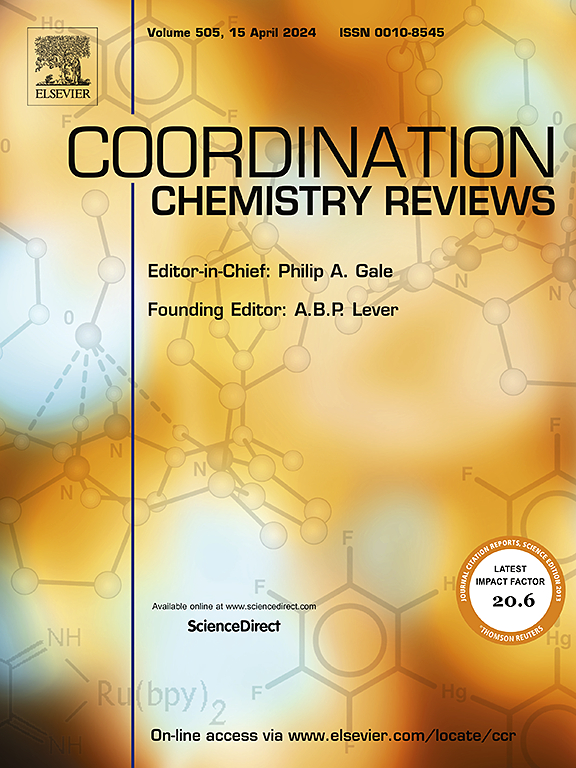超越化疗:深部组织精准医学中金属配合物的时空激活
IF 20.3
1区 化学
Q1 CHEMISTRY, INORGANIC & NUCLEAR
引用次数: 0
摘要
金属基配合物已成为抗癌治疗中强有力的药物,表现出特殊的活性,并将自己定位为该领域非常有前途的候选者。其中,铂类抗肿瘤药物在目前的化疗方案中被广泛使用。然而,它们的临床应用受到耐药性、非特异性生物分布和不可逆毒性等挑战的极大限制。最近的进展强调,金属基药物通过外部辐射的精确时空激活提供了一种不同于传统化疗的新作用机制。这种方法提高了治疗效果,同时减轻了副作用和交叉耐药性,解决了传统金属基治疗方法固有的关键局限性。外部刺激,包括近红外(NIR)光、超声波(US)和x射线,与紫外可见光相比,具有更好的组织穿透性,使它们特别有利于靶向深部肿瘤。在此框架下,我们全面回顾了金属基药物通过近红外光、美国和x射线活化的最新进展,重点关注分子金属配合物、超分子配位配合物和金属有机框架。涉及的关键方面包括它们的设计原理、光物理和光化学性质以及生物医学应用。最后,我们讨论了这些金属配合物在生物医学领域和临床翻译中的困难和未来的发展方向。本文章由计算机程序翻译,如有差异,请以英文原文为准。
Beyond chemotherapy: Spatiotemporal activation of metal complexes for deep-tissues precision medicine
Metal-based complexes have emerged as powerful agents in anticancer therapy, demonstrating exceptional activity and positioning themselves as highly promising candidates in the field. Among these, platinum-based antitumor drugs are extensively employed in current chemotherapy protocols. However, their clinical utility is significantly constrained by challenges such as drug resistance, non-specific biodistribution, and irreversible toxicities. Recent advances underscore that precise spatiotemporal activation of metal-based drugs through external radiation offers a novel mechanism of action distinct from conventional chemotherapy. This approach enhances therapeutic efficacy while simultaneously mitigating side effects and cross-resistance, addressing pivotal limitations inherent to traditional metal-based therapeutics. External stimuli, including near-infrared (NIR) light, ultrasound (US), and X-rays, possess superior tissue penetration compared to ultraviolet-visible light, rendering them particularly advantageous for targeting deep-seated tumors. Within this framework, we comprehensively review recent developments in the activation of metal-based drugs via NIR light, US, and X-rays, with a focus on molecular metal complexes, supramolecular coordination complexes, and metal-organic frameworks. Critical aspects covered include their design principles, photophysical and photochemical properties, and biomedical applications. Finally, we address the difficulties and future directions for the biomedical field and clinical translation of these metal complexes.
求助全文
通过发布文献求助,成功后即可免费获取论文全文。
去求助
来源期刊

Coordination Chemistry Reviews
化学-无机化学与核化学
CiteScore
34.30
自引率
5.30%
发文量
457
审稿时长
54 days
期刊介绍:
Coordination Chemistry Reviews offers rapid publication of review articles on current and significant topics in coordination chemistry, encompassing organometallic, supramolecular, theoretical, and bioinorganic chemistry. It also covers catalysis, materials chemistry, and metal-organic frameworks from a coordination chemistry perspective. Reviews summarize recent developments or discuss specific techniques, welcoming contributions from both established and emerging researchers.
The journal releases special issues on timely subjects, including those featuring contributions from specific regions or conferences. Occasional full-length book articles are also featured. Additionally, special volumes cover annual reviews of main group chemistry, transition metal group chemistry, and organometallic chemistry. These comprehensive reviews are vital resources for those engaged in coordination chemistry, further establishing Coordination Chemistry Reviews as a hub for insightful surveys in inorganic and physical inorganic chemistry.
 求助内容:
求助内容: 应助结果提醒方式:
应助结果提醒方式:


